Thirty-two professors. Ten weeks of summer. One shiny new Science Center filled with a record number of Amherst College students participating in SURF, the Summer Undergraduate Research Fellowship. The fellowship gives first- and second-year students the chance to assist on a research project in a professor’s discipline. Starting in early June, SURF researchers receive a weekly salary, as well as on-campus housing and a meal plan. After completing all facets of Amherst’s lab safety and research ethics training, they get to work. Here are a few of their stories.
Jin Jeon ’22

L: Magnified view of embryonic sea anemones (Nematostella vectensis) from the lab of Katerina Ragkousi, assistant professor of biology. The normally colorless anemones are marked with a green fluorescent protein to track the dynamic behavior of a protein called actin. Actin has many important jobs in a cell, including establishing the cell’s shape.
R: SURF researcher Jin Jeon ’22 sits at the microinjection station where she painstakingly inserted tiny rings of DNA into sea anemone embryos. Jeon’s work will contribute to a Ragkousi lab publication on the role of the cytoskeleton during embryonic development.
If the tiny glass pipette slipped even a little, it could spell disaster for the sensitive embryo. It required a very steady hand—and weeks of advanced training and practice—for Jin Jeon ’22 to learn how to use the microinjection station that would alter the developing sea anemones. For most of the summer, Jeon’s research tasks in Professor Katerina Ragkousi’s molecular biology lab were invisible to the eye. It took an agonizing eight weeks to finish constructing the plasmids, or tiny rings of DNA, in host bacteria. Then came the tricky work of introducing the plasmids into the sea anemone embryos, each smaller than the head of a pin.
In nature, few sea anemone eggs survive to maturity. In the lab, Jeon knew that only one in five would make it through the microinjection procedure, and only some of those would successfully get fertilized and start to grow. “There was a time when I thought, ‘Oh, this is probably never gonna happen,’” says Jeon. “I struggled a lot.”
Finally, in the waning weeks of summer, Jeon reached her project goals and claimed her reward: a chance to use a confocal microscope to observe in real time how the injected embryos were developing. “That was extremely satisfying,” says Jeon. She credits both Professor Ragkousi and the lab’s research specialist, Alivia Price, with giving her the biggest gift of the SURF summer experience: “Perseverance!”
Quinten McElhiney ’22
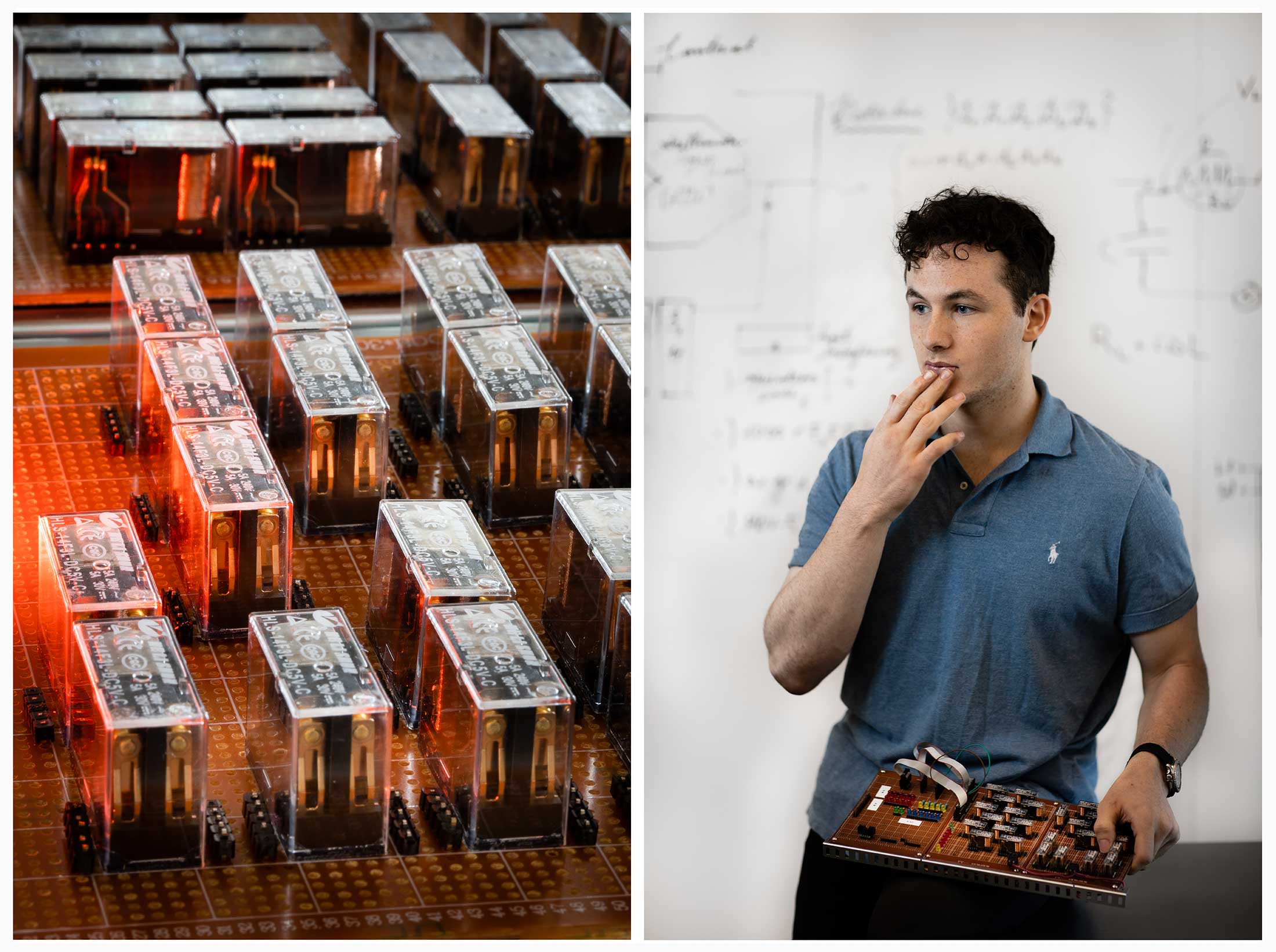
L: Close-up of a homemade relay computer, which contains none of the integrated circuits that have, since the 1960s, allowed computers to get faster and more powerful. With technology that was state-of-the-art around 1940, the relay computer is capable of basic arithmetic functions.
R: SURF researcher Quinten McElhiney ’22 built the relay computer at the suggestion of computer science professor Scott Alfeld. The simple machine helps students visualize what happens when a computer system is brought down by an attack on its energy management.
“You buy your new phone, and it works, and you don’t think about how,” says Quinten McElhiney ’22. “It’s a black-box mentality.”
This summer, McElhiney got to shine a light into that black box.
As a student who plans to triple-major in math, computer science and philosophy, McElhiney feels at home in the world of theory. When he sought to work with Professor Scott Alfeld as a SURF researcher, he imagined an assignment aligned with the computer science professor’s research on security. “I thought I’d be working in the abstract and whimsical world of mathematics,” laughs McElhiney.
Instead, Alfeld proposed a project that bridged theory and application. With support from Professor of Computer Science Scott Kaplan and Shira Epstein, director of campus makerspaces at UMass Amherst, Alfeld and McElhiney collaborated to design, and build from scratch, a mechanical relay computer. The handmade machine has no keyboard and no screen—just blocky, translucent components that click and light up as it performs basic addition and subtraction. Oh, and the intentionally limited computer does one more thing: it allows cybersecurity researchers to visualize real-world security vulnerabilities.
The creation will live on in the computer science department as a pedagogical tool. “It’s big and clunky and inefficient, and that’s so we might observe the actual behavior,” says McElhiney. “I went back so that we could go forward—so we could understand how computers work at the most basic level.”
Eleanor Hollers ’21
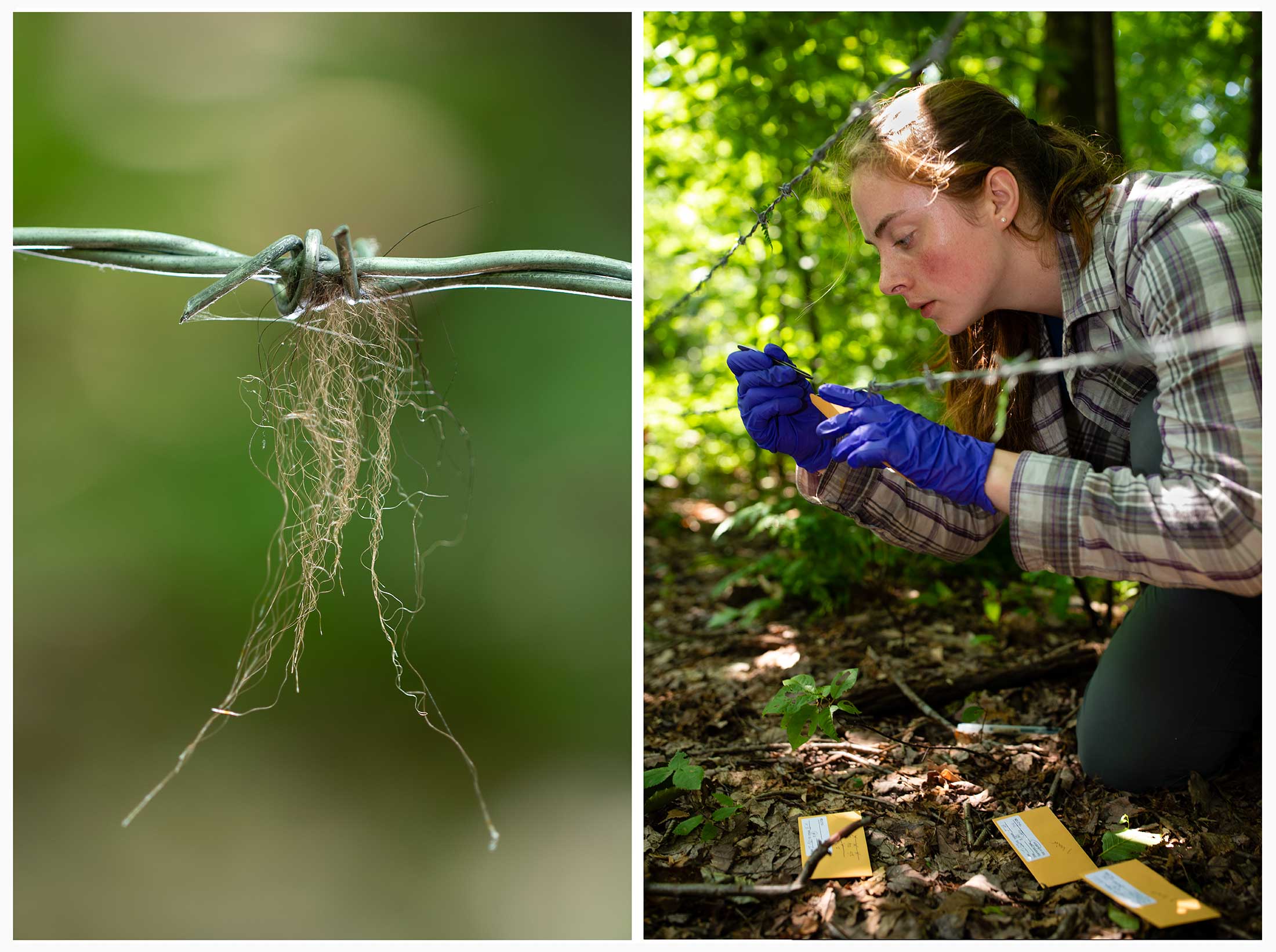
L: Black bear hair left behind on a ring of elevated barbed wire. A scented lure draws bears to brush against the wires, leaving behind hair samples. Biology Laboratory Coordinator Thea Kristensen and her students extract DNA from the skin follicles attached to the hair, and then genotype the DNA to determine which bear is which and to match samples across locations and time. Data from the study will help inform state policies on bear management.
R: SURF researcher Eleanor Hollers ’21 collects hair samples from one of the 122 bear hair corrals set up across the state this summer as part of the MassBears project, which is estimating the population size and distribution of black bears in Massachusetts. The project is led by Kristensen, in collaboration with Kathy Zeller and Steve DeStefano from UMass Amherst and Dave Wattles from MassWildlife.
If you live in Massachusetts, you know this already: The bears are coming back.
“In the mid-1800s, bears were pretty much extirpated from Massachusetts by hunting and deforestation,” says Eleanor Hollers ’21. Now, more than 150 years later, hunting is regulated, and pockets of dense forest have returned, restoring the bears’ habitat. In areas just beyond cities and suburbs, bear populations can thrive thanks to humans’ garbage cans and backyard bird feeders.
Thea Kristensen, biology laboratory coordinator, leads the team of students who are helping conduct the state’s first bear population study since 1993. In collaboration with MassWildlife, the Massachusetts Cooperative Fish and Wildlife Research Unit and UMass Amherst, Kristensen and her team are estimating the population size of the state’s black bears and determining how they are distributed east and west of the Connecticut River.
To do this, they used a noninvasive survey technique: hair corrals. A hair corral consists of two parallel strands of barbed wire wrapped low around a small circle of trees. At the center of each circle, researchers suspended a lure doused with various liquid scents appealing to bears. (Judie’s Restaurant in Amherst donated cooking oil for this purpose.) As the bears passed through the wires to investigate, they left behind more than 1,870 hair samples for Kristensen’s team to collect for lab analysis.
Aspiring veterinarian Hollers relished the research assignment that gave her ample time outdoors—plus one actual bear encounter. “I’m a crazy animal lover,” she says. “If vet school doesn’t work out, scientific fieldwork would be a good alternative.”
Ikram Gabiyev ’22
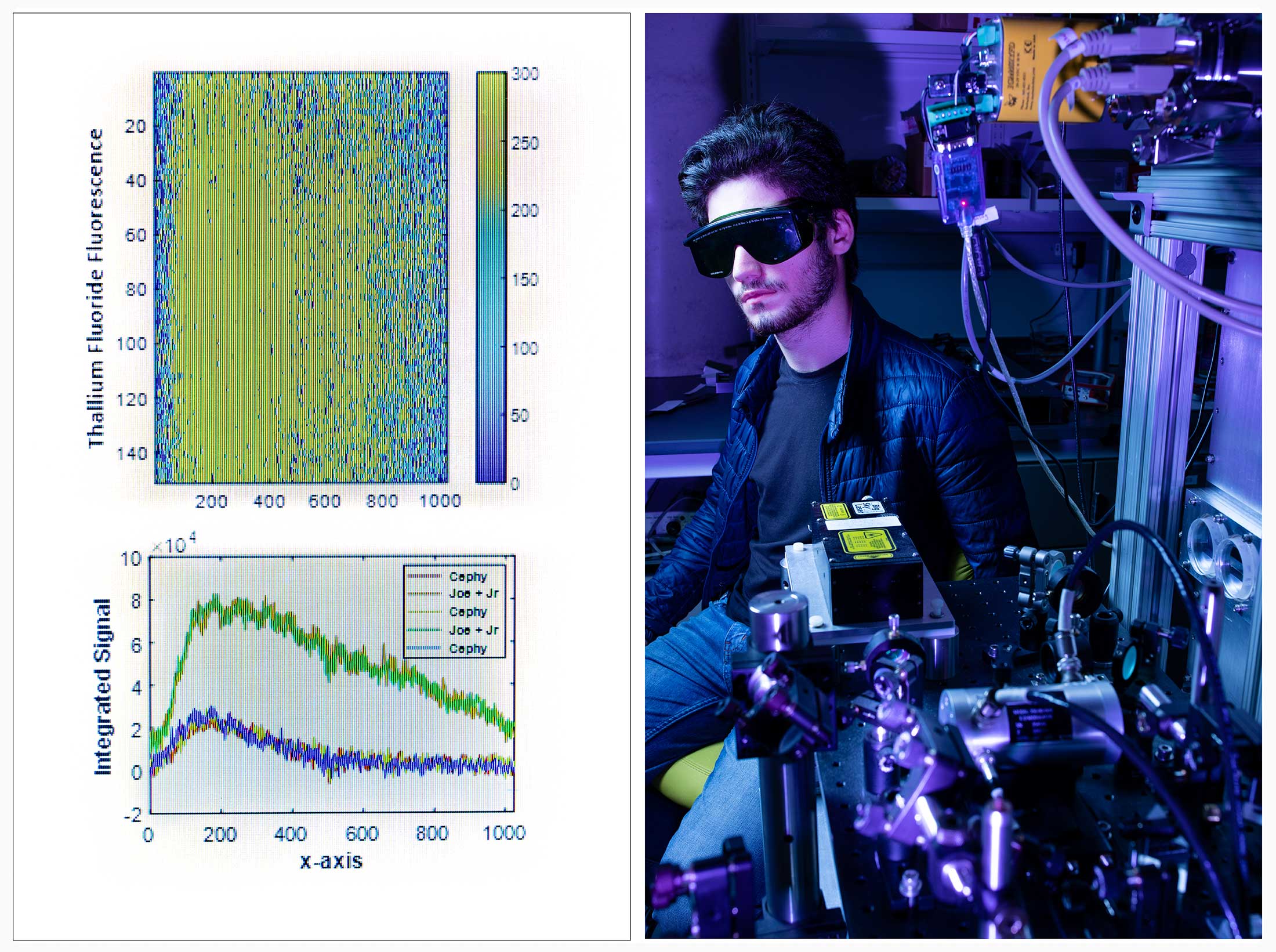
L: In Professor Larry Hunter’s physics lab, researchers contribute to the Yale-based CeNTREX experiment to measure the electric dipole moment (EDM) of a nucleus. This screen shows the fluorescence, or emission of electromagnetic radiation, at the moment when two overlapping UV lasers make multiple passes through a cold molecular beam.
R: SURF researcher Ikram Gabiyev ’22 poses by a YAG laser in the Hunter lab. The laser creates the cold molecular beam by vaporizing thallium fluoride molecules that are then cooled through collisions with an extremely cold helium buffer gas. Safety glasses are essential when adjusting the lasers and optics. When the YAG laser is firing, Gabiyev and his colleagues observe the resulting fluorescence on a computer monitor in another room.
Physics professor Larry Hunter knows a thing or two about taking the long view. When new students apply to work in his lab, he warns them, “We do hard experiments that may take years to complete.”
Enter Ikram Gabiyev ’22, whose deadpan demeanor can’t mask how pleased he is to work in the Hunter lab, which he calls “noble.” To get started, Gabiyev had to undergo laser training—and a crash course in quantum mechanics.
Gabiyev’s primary task was to work with Postdoctoral Research Associate Nathan Clayburn to confirm an observation of the optical cycling of thallium fluoride. He used a laser to vaporize molecules from a solid target. The liberated molecules were then cooled (through collisions with chilled helium atoms) and collimated to form a cold thallium-fluoride beam. When the beam was illuminated with a pair of overlapping UV lasers, each molecule would (ideally) absorb and emit at least 50 photons. By coaxing each molecule to emit 50 photons, Gabiyev ensured that every molecule could be detected, a requirement for the success of Yale’s CeNTREX experiment, of which Hunter’s lab is a part.
Because Gabiyev’s assignment demanded so much precision, a lot could go wrong. For several weeks, he couldn’t achieve more than 20 photons. “I was pretty annoyed with this,” he says. In a breakthrough moment, he adjusted the UV laser optics and finally achieved his goal. “Even though I was not showing a lot of emotion,” says Gabiyev, “there was a huge smile on the face of my soul.”
Julia Ruggiero ’21
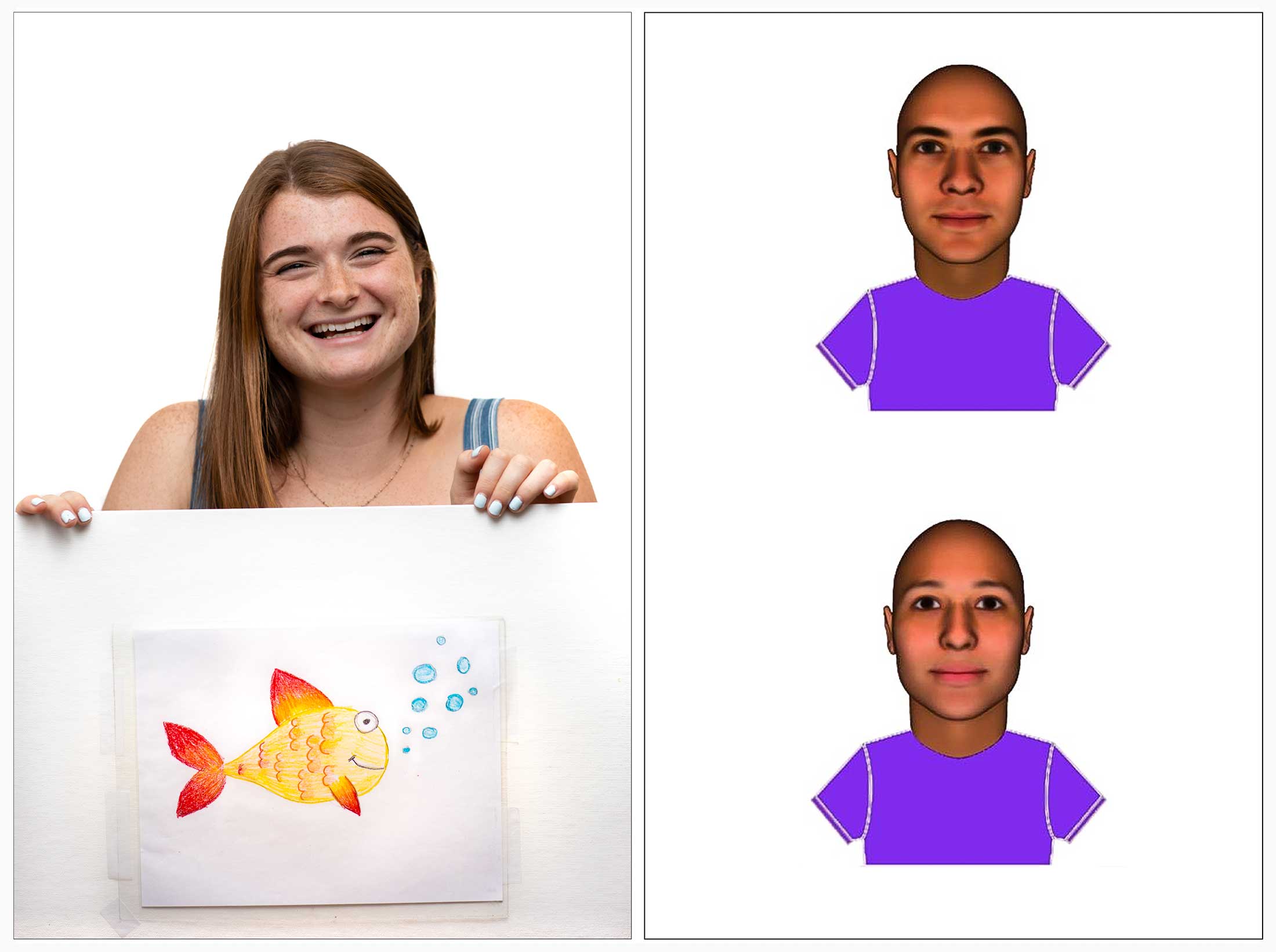
L: SURF researcher Julia Ruggiero ’21 poses with artwork from the Child Learning and Development (CLAD) Lab, which is led by Carolyn Palmquist, assistant professor of psychology. This summer, Ruggiero interviewed child study participants in the CLAD Lab and in local schools and daycare centers.
R: Example of faces deemed “competent” (top) and “trustworthy” (bottom) by adults who rated the images. The computer-generated face pairings, which come from Princeton University’s Social Perception Lab databases, are one tool in Professor Palmquist’s ongoing research into how young children learn from others.
Kids learn about the world in two ways: by firsthand experience and by the information that others share with them. It’s “Ouch! This sidewalk is hot” versus “I should put my shoes on because Mommy says this sidewalk is hot.”
In the second version, how do children decide when and why to trust an information source? Are nonverbal cues at play?
Previous psychology studies examined children’s reactions to faces rated by adults as either “trustworthy” or “untrustworthy.” Professor Carolyn Palmquist considers a new question: How do faces considered “trustworthy” or “competent” influence kids’ predictions about unfamiliar grown-ups?
SURF researchers Julia Ruggiero ’21 and Katie Crum ’21 spent the summer recruiting and interviewing 4- and 5-year-olds for the latest version of Palmquist’s trustworthy-vs.-competent predictions study. Under Palmquist’s guidance, Ruggiero and Crum learned how to read a scholarly article, how to code an interview for data collection, and how to interview children with careful neutrality. “We avoid telling kids, ‘Great job,’ because there’s not any right or wrong way [to participate],” says Ruggiero.
Presented with an array of computer-amalgamated face pairs with skin in all different hues, children were asked social (trustworthiness) questions and object function (competence) questions to gauge how they perceived the faces. Although 4-year-olds chose randomly between the faces when asked both the social and object function questions, 5-year-olds preferred trustworthy faces for social questions and competent faces for object function questions. This suggests that, somewhere between ages 4 and 5, children begin to draw inferences about skills associated with specific facial traits.
Andres Nino ’22
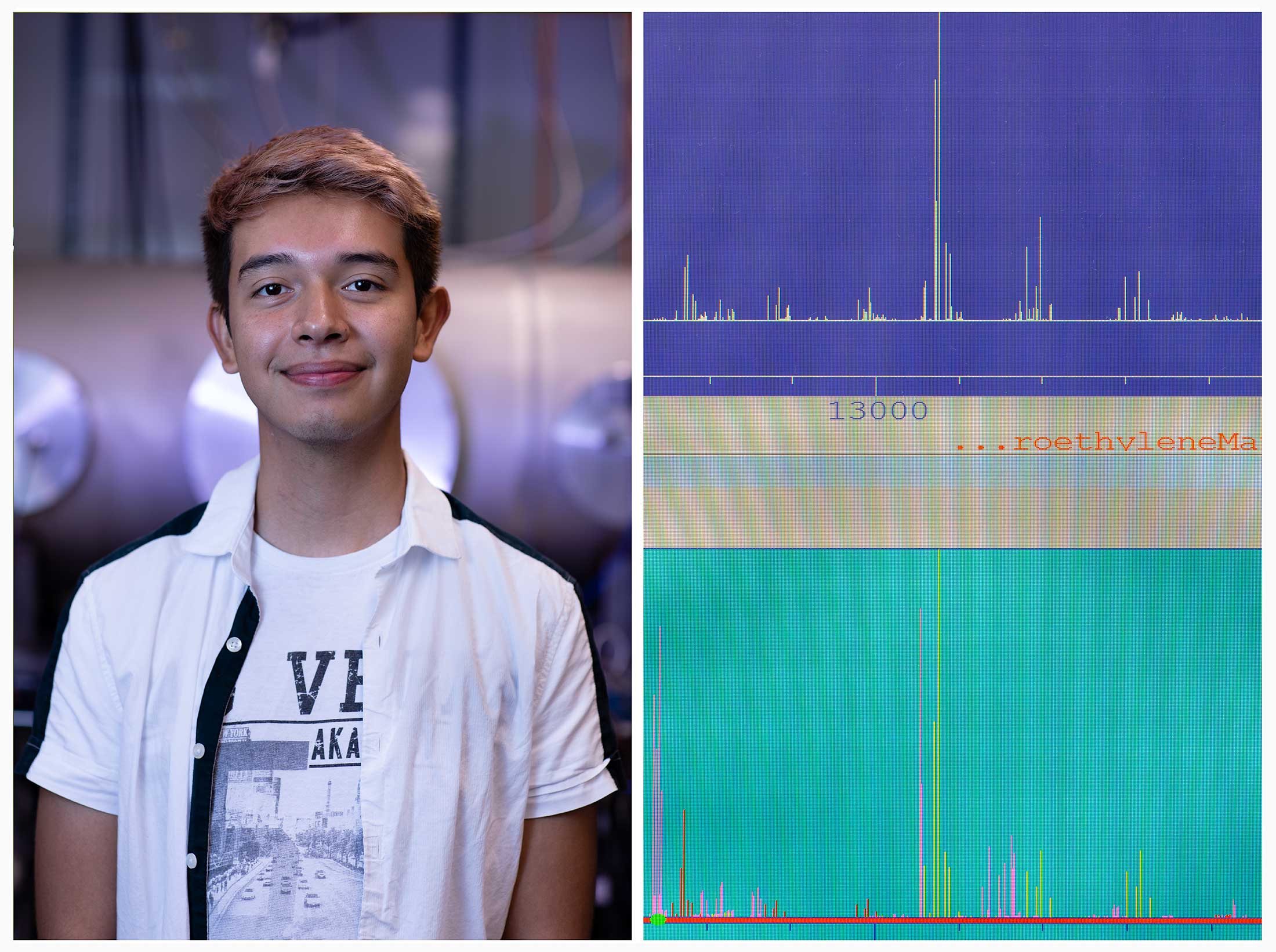
L: SURF researcher Andres Nino ’22 stands in front of the microwave spectrometer in the lab of chemistry professors Helen Leung and Mark Marshall.
R: A computer rendering of experimental data (blue) from the microwave spectrometer and the theoretical or predictive data (turquoise). Comparing the two helps determine the structure of a molecule.
Even before he arrived at Amherst, Andres Nino ’22 knew he would major in chemistry. “Chemistry was my love, my passion,” he says. But it wasn’t until Nino worked in the lab with Professors Helen Leung and Mark Marshall that he realized how well-suited he is to the subfield of physical chemistry.
Physical chemists give us insight into what is happening beyond the realm of appearances. For example, when water flows out of a tap, most of us don’t think about the shape of the water molecules. But molecular shape matters—profoundly. Shape determines what can happen inside a molecule and how it will interact with other molecules. It’s no exaggeration to say that molecular shapes create our physical reality.
Professors Leung and Marshall have spent three decades determining molecular shapes with a technique called microwave spectroscopy. With their guidance, Nino used quantum chemistry—basically, the laws of quantum mechanics applied to atoms and molecules—to visualize the shape of an ethylene molecule. It was “a completely new experience for me,” Nino says. “These are things you learn in junior year, higher-level chemistry classes,” and even then, only on a simple level.
Nino describes the field of spectroscopy as “a stepping-stone” for unlocking insights about how things are created and why molecules move the way they do. The accumulated insights can produce new predictions or interventions. Nino has a prediction of his own: “I know that someday, when there’s some big discovery made, it will be based on the idea of quantum chemistry.”
Hannah Neiditz ’21 and Lauren McNeil ’21

L: SURF researcher Hannah Neiditz ’21 stands with the epifluorescence microscope that she used to study zebrafish this summer in the lab of Josef Trapani, associate professor of biology and neuroscience. The Trapani lab is currently using zebrafish to better understand hearing loss and balance disorders.
R: SURF researcher Lauren McNeil ’21 sits at a workstation in the Trapani lab, where she spent the summer measuring the startle reflex in live zebrafish. The data she collected will be used to examine similarities between zebrafish sensory systems and the auditory system in humans.
Humans, it turns out, are a lot like zebrafish. The tiny freshwater fish are only 2.5 to 4 centimeters long when full-grown, and yet we share about 70 percent of the same genes.
Two humans who spent a lot of time appreciating zebrafish this summer are Hannah Neiditz ’21 and Lauren McNeil ’21, SURF researchers in the lab of Professor Josef Trapani. “There are many reasons why zebrafish are such good research subjects,” says McNeil: Zebrafish reproduce quickly. Zebrafish embryos, which develop outside of their mothers’ bodies, grow as much in one day as a human embryo does in a month. In the larval stage, zebrafish have translucent skin, which makes their insides easy to view under a microscope.
Neiditz and McNeil spent 10 weeks observing, filming and measuring zebrafish in support of Trapani’s current inquiry into auditory processes and hearing loss. Both women plan to go to medical school someday, and both declined clinical internships in large cities to take advantage of Amherst’s on-campus summer research experience.
They have no regrets.
“It’s kind of crazy to think about how far we’ve come,” says Neiditz. In just 10 weeks, the novice SURF researchers were transformed into a high-functioning team, smoothly attending to a set of clearly delineated responsibilities. Neiditz was pleased to discover “how interactive these labs are and how everyone’s individual projects contribute to a larger goal.”
McNeil appreciated Trapani’s trust in his students. “I’ve definitely become more independent and confident in my ability to solve problems,” she says.
Zebrafish
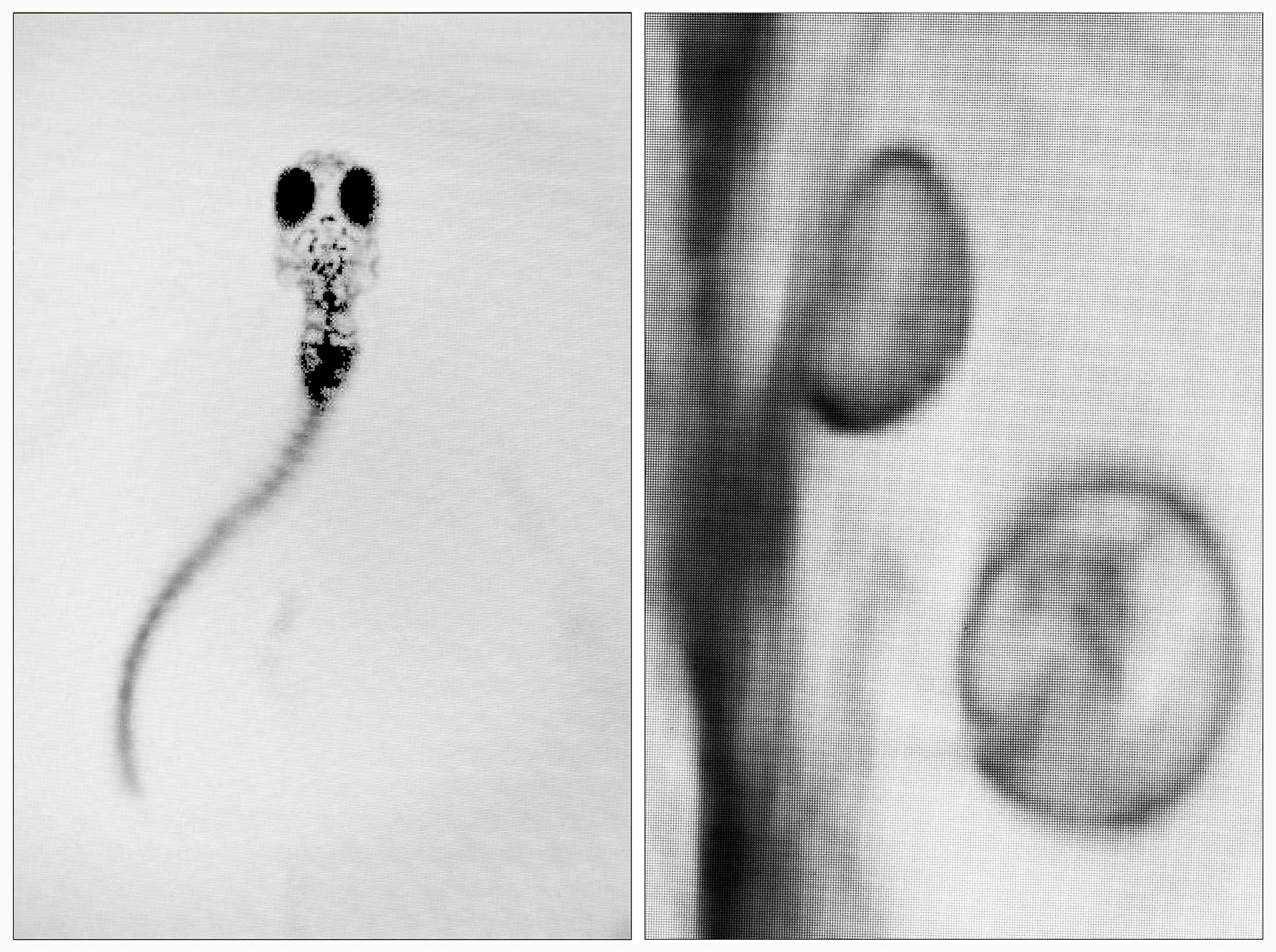
L: A developing zebrafish viewed from above. The larva has an inner ear and lateral line system that both use hair cells that are similar to the hair cells in human inner ears. Stimulating the hair cells allows researchers to measure the fish’s startle reflex, which is seen here as a tail-flick because the head has been kept stationary.
R: The anterior and posterior macula of the larval zebrafish ear viewed at high magnification through an upright epifluorescence microscope. The macular organs detect sound vibrations and play a large role in the systems that make it possible for the fish to hear and maintain their balance.